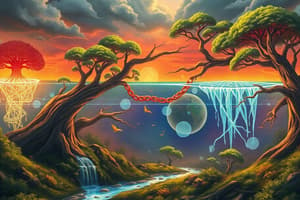Podcast
Questions and Answers
What is the primary role of producers in an ecosystem?
What is the primary role of producers in an ecosystem?
Producers convert solar energy into chemical energy through photosynthesis.
Define abiotic factors and give two examples.
Define abiotic factors and give two examples.
Abiotic factors are non-living elements of an ecosystem, such as soil and water.
What are decomposers and why are they important?
What are decomposers and why are they important?
Decomposers, like fungi and bacteria, break down dead organic matter, recycling nutrients back into the ecosystem.
Describe the nitrogen cycle in one sentence.
Describe the nitrogen cycle in one sentence.
What distinguishes primary succession from secondary succession?
What distinguishes primary succession from secondary succession?
List the four trophic levels in an ecosystem.
List the four trophic levels in an ecosystem.
What impact do natural disturbances have on ecosystems?
What impact do natural disturbances have on ecosystems?
Explain ecosystem resilience in two sentences.
Explain ecosystem resilience in two sentences.
What constitutes biogeochemical cycles, and why are they essential?
What constitutes biogeochemical cycles, and why are they essential?
How do human-induced disturbances differ from natural disturbances?
How do human-induced disturbances differ from natural disturbances?
Flashcards are hidden until you start studying
Study Notes
Ecosystem Dynamics
-
Definition: Ecosystem dynamics refers to the patterns and processes of interactions within an ecosystem, including the flow of energy and the cycling of nutrients.
-
Components of Ecosystems:
- Biotic Factors: Living organisms (plants, animals, microorganisms).
- Abiotic Factors: Non-living elements (soil, water, climate, nutrients).
-
Energy Flow:
- Producers: Organisms (primarily plants) that convert solar energy into chemical energy through photosynthesis.
- Consumers: Organisms that depend on others for energy (herbivores, carnivores, omnivores).
- Decomposers: Organisms (fungi, bacteria) that break down dead organic matter, recycling nutrients back into the ecosystem.
-
Trophic Levels:
- Primary Producers: First level, autotrophs (e.g., plants).
- Primary Consumers: Second level, herbivores (e.g., rabbits).
- Secondary Consumers: Third level, carnivores that eat herbivores (e.g., snakes).
- Tertiary Consumers: Fourth level, top predators (e.g., hawks).
-
Nutrient Cycling:
- Biogeochemical Cycles: Movement of essential elements (carbon, nitrogen, phosphorus) between living and non-living parts of the ecosystem.
- Carbon Cycle: Involves photosynthesis, respiration, decomposition, and fossil fuel combustion.
- Nitrogen Cycle: Includes nitrogen fixation, nitrification, assimilation, and denitrification.
-
Succession:
- Primary Succession: Development of an ecosystem in a previously uninhabited area (e.g., after a volcanic eruption).
- Secondary Succession: Recovery of an ecosystem after a disturbance (e.g., fire, flood).
-
Disturbance and Resilience:
- Natural Disturbances: Events like hurricanes, wildfires, and floods that can alter ecosystems.
- Human-Induced Disturbances: Activities such as deforestation, pollution, and urban development.
- Ecosystem Resilience: The ability of an ecosystem to recover from disturbances.
-
Biodiversity:
- Importance: Higher biodiversity generally increases ecosystem stability and resilience.
- Threats: Habitat destruction, climate change, invasive species, overexploitation.
-
Ecosystem Services:
- Provisioning Services: Products obtained from ecosystems (food, fresh water).
- Regulating Services: Benefits obtained from regulation of ecosystem processes (climate regulation, flood control).
- Cultural Services: Non-material benefits (recreational, aesthetic).
- Supporting Services: Necessary for the production of all other ecosystem services (nutrient cycling, soil formation).
Understanding ecosystem dynamics is crucial for effective environmental management and conservation efforts.
Ecosystem Dynamics Overview
- Ecosystem dynamics encompasses interactions among living and non-living elements, highlighting energy flows and nutrient cycling.
Components of Ecosystems
- Biotic Factors: Include all living organisms, such as plants, animals, and microorganisms.
- Abiotic Factors: Comprise non-living elements vital for ecosystems, including soil, water, climate, and nutrients.
Energy Flow in Ecosystems
- Producers: Autotrophic organisms, primarily plants, harness solar energy via photosynthesis to produce chemical energy.
- Consumers: Heterotrophic organisms that rely on producers or other consumers for energy, categorized as herbivores, carnivores, and omnivores.
- Decomposers: Organisms like fungi and bacteria that decompose dead organic matter, essential for nutrient recycling in ecosystems.
Trophic Levels
- Primary Producers: The foundational trophic level consisting of autotrophs, primarily plants.
- Primary Consumers: Herbivores that consume primary producers, such as rabbits.
- Secondary Consumers: Carnivores that prey on primary consumers, including organisms like snakes.
- Tertiary Consumers: Apex predators at the top of the food chain, such as hawks.
Nutrient Cycling
- Biogeochemical Cycles: Essential element movements (carbon, nitrogen, phosphorus) interlinking living and non-living parts of ecosystems.
- Carbon Cycle: Integrates processes like photosynthesis, respiration, decomposition, and fossil fuel combustion.
- Nitrogen Cycle: Encompasses nitrogen fixation, nitrification, assimilation, and denitrification.
Succession in Ecosystems
- Primary Succession: Establishment of ecosystems in lifeless areas, such as post-volcanic eruption landscapes.
- Secondary Succession: Ecosystem recovery after disturbances, like those caused by fire or flooding.
Disturbance and Resilience
- Natural Disturbances: Include hurricanes, wildfires, and floods, which can significantly modify ecosystems.
- Human-Induced Disturbances: Activities such as deforestation, pollution, and urbanization that disrupt ecosystems.
- Ecosystem Resilience: Refers to an ecosystem's capacity to rebound from disturbances effectively.
Biodiversity
- Importance: Higher biodiversity often leads to greater ecosystem stability and resilience against changes.
- Threats to Biodiversity: Habitat destruction, climate change, invasive species, and overexploitation jeopardize biodiversity.
Ecosystem Services
- Provisioning Services: Material benefits obtained from ecosystems like food and fresh water.
- Regulating Services: Ecosystem processes that regulate environmental conditions, including climate and flood management.
- Cultural Services: Non-material benefits, such as recreational and aesthetic value.
- Supporting Services: Fundamental services required for producing other ecosystem services, including nutrient cycling and soil formation.
Understanding ecosystem dynamics is critical for improving environmental management and conservation strategies.
Studying That Suits You
Use AI to generate personalized quizzes and flashcards to suit your learning preferences.




